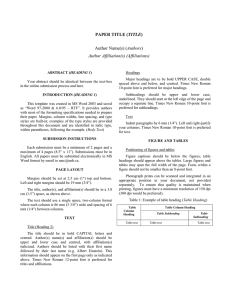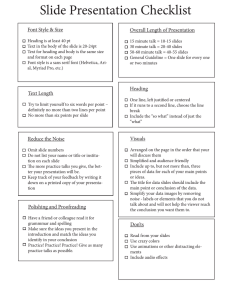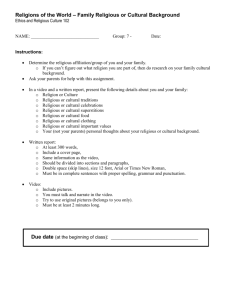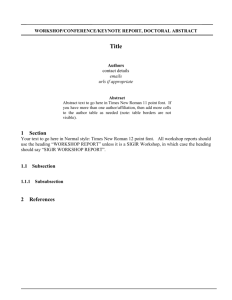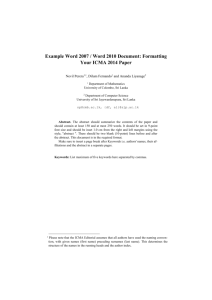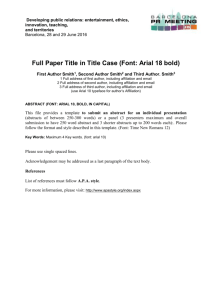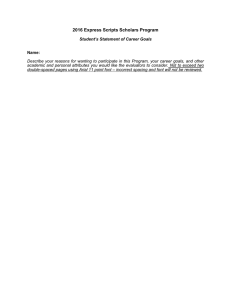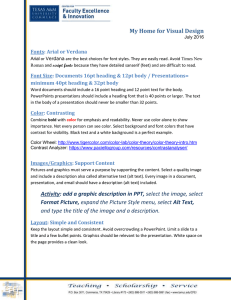PAPER TITLE (TITLE) Author Name(s) (Authors) Author
advertisement
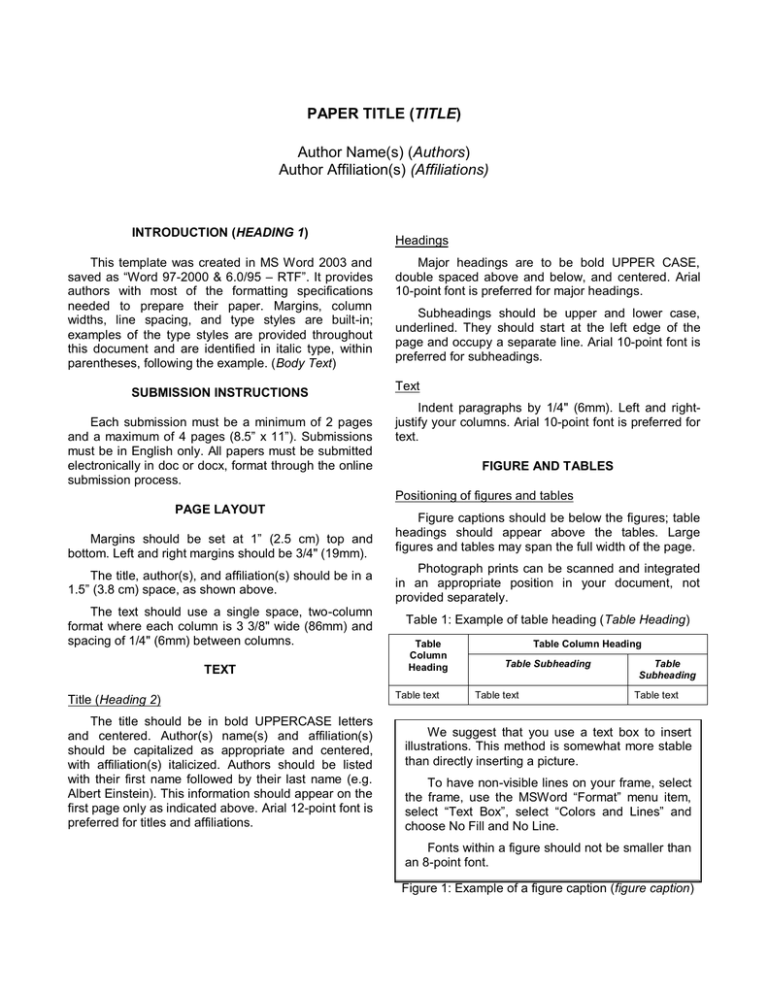
PAPER TITLE (TITLE) Author Name(s) (Authors) Author Affiliation(s) (Affiliations) INTRODUCTION (HEADING 1) This template was created in MS Word 2003 and saved as “Word 97-2000 & 6.0/95 – RTF”. It provides authors with most of the formatting specifications needed to prepare their paper. Margins, column widths, line spacing, and type styles are built-in; examples of the type styles are provided throughout this document and are identified in italic type, within parentheses, following the example. (Body Text) SUBMISSION INSTRUCTIONS Each submission must be a minimum of 2 pages and a maximum of 4 pages (8.5” x 11”). Submissions must be in English only. All papers must be submitted electronically in doc or docx, format through the online submission process. Headings Major headings are to be bold UPPER CASE, double spaced above and below, and centered. Arial 10-point font is preferred for major headings. Subheadings should be upper and lower case, underlined. They should start at the left edge of the page and occupy a separate line. Arial 10-point font is preferred for subheadings. Text Indent paragraphs by 1/4" (6mm). Left and rightjustify your columns. Arial 10-point font is preferred for text. FIGURE AND TABLES Positioning of figures and tables PAGE LAYOUT Margins should be set at 1” (2.5 cm) top and bottom. Left and right margins should be 3/4" (19mm). The title, author(s), and affiliation(s) should be in a 1.5” (3.8 cm) space, as shown above. The text should use a single space, two-column format where each column is 3 3/8" wide (86mm) and spacing of 1/4" (6mm) between columns. TEXT Title (Heading 2) The title should be in bold UPPERCASE letters and centered. Author(s) name(s) and affiliation(s) should be capitalized as appropriate and centered, with affiliation(s) italicized. Authors should be listed with their first name followed by their last name (e.g. Albert Einstein). This information should appear on the first page only as indicated above. Arial 12-point font is preferred for titles and affiliations. Figure captions should be below the figures; table headings should appear above the tables. Large figures and tables may span the full width of the page. Photograph prints can be scanned and integrated in an appropriate position in your document, not provided separately. Table 1: Example of table heading (Table Heading) Table Column Heading Table text Table Column Heading Table Subheading Table text Table Subheading Table text We suggest that you use a text box to insert illustrations. This method is somewhat more stable than directly inserting a picture. To have non-visible lines on your frame, select the frame, use the MSWord “Format” menu item, select “Text Box”, select “Colors and Lines” and choose No Fill and No Line. Fonts within a figure should not be smaller than an 8-point font. Figure 1: Example of a figure caption (figure caption) EQUATIONS It is suggested that adequate space be allowed between each equation and adjacent text. This is especially important when subscripts and superscripts are used. E = mc2 (1) ACKNOWLEDGEMENTS REFERENCES Unless there are six authors or more give all authors' names; do not use “et al”. References and citations should be prepared in accordance with the APA Publication Manual, 5th ed. Cite in the text by author and year of publication (Smith, 1983) and include an alphabetical list at the end of the article. Accuracy of reference data is the responsibility of the author. Examples: Journal article: Jutai, J.W., Rigby, P., Ryan, S., & Stickel, S. (2000). Psychosocial impact of electronic aids to daily living. Assistive Technology, 12, 123–131. Book: Staney, K.M. (2002). Handbook of virtual environments: Design, implementation, and applications. Mahwah, NJ: Erlbaum. Proceedings or Chapter in a Book: Smit, R.O. (2002). Assistive technology outcome assessment prototypes: Measuring “INGO” variables of “outcomes.” in R. Simpson (Ed.), Proceedings of the RESNA 25th Annual Conference (pp. 239–341). Minneapolis, MN: RESNA Press. Website: Electronic and Mechanical Assistive Technologies (2002). Ziska environmental control unit. Retrieved December 10, 2003, from http:// www.hsc.mb.ca/re/catalogue/env_remove.htm
